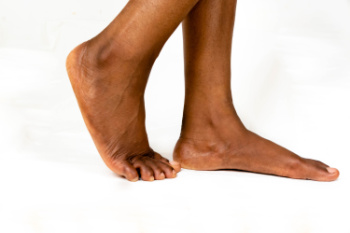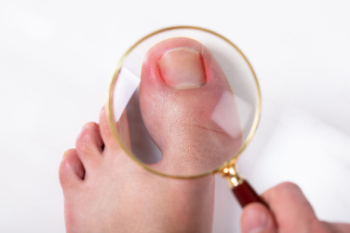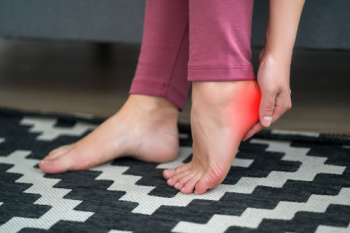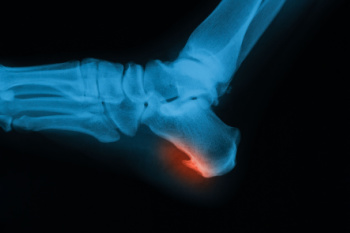Connect With Us
Blog
Items filtered by date: September 2024
Dealing With the Effects of Flat Feet

Flat feet, or fallen arches, occur when the arch of the foot is low or completely flattened, causing the entire sole to make contact with the ground. Having flat feet can affect the natural alignment of the body, potentially leading to pain in the feet, ankles, knees, or lower back. While flat feet do not always cause symptoms, common signs include foot pain, fatigue, and uneven shoe wear. This condition can arise from a failure of the arches to develop properly during childhood, or it can develop later in life due to aging, injury, or certain medical conditions like arthritis or diabetes. Treatment often focuses on reducing pain and improving foot function through the use of custom orthotics or supportive shoes, which help redistribute weight and improve alignment. In more severe cases, where pain persists or mobility is affected, surgery may be considered to reconstruct the arch or correct deformities. If you have persistent foot pain as a result of flat feet, it is suggested that you make an appointment with a podiatrist for treatment options.
Flatfoot is a condition many people suffer from. If you have flat feet, contact one of our podiatrists from New Jersey Foot & Ankle Centers. Our doctors will treat your foot and ankle needs.
What Are Flat Feet?
Flatfoot is a condition in which the arch of the foot is depressed and the sole of the foot is almost completely in contact with the ground. About 20-30% of the population generally has flat feet because their arches never formed during growth.
Conditions & Problems:
Having flat feet makes it difficult to run or walk because of the stress placed on the ankles.
Alignment – The general alignment of your legs can be disrupted, because the ankles move inward which can cause major discomfort.
Knees – If you have complications with your knees, flat feet can be a contributor to arthritis in that area.
Symptoms
- Pain around the heel or arch area
- Trouble standing on the tip toe
- Swelling around the inside of the ankle
- Flat look to one or both feet
- Having your shoes feel uneven when worn
Treatment
If you are experiencing pain and stress on the foot you may weaken the posterior tibial tendon, which runs around the inside of the ankle.
If you have any questions please feel free to contact our office located in Oradell, NJ . We offer the newest diagnostic and treatment technologies for all your foot and ankle needs.
Managing Ingrown Toenails

Ingrown toenails occur when the edge of the toenail grows into the surrounding skin, causing pain and discomfort. This condition commonly affects the big toe and can result from improper nail trimming, wearing tight shoes, or genetic predisposition. Early symptoms include redness, swelling, and tenderness along the nail edges. If left untreated, ingrown toenails can lead to infection, abscesses, and chronic pain, which may complicate walking or lead to more severe health issues. Individuals with poor nail-cutting habits, wearing tight footwear, or certain foot deformities are at higher risk. Diagnosis typically involves a physical examination, during which a podiatrist will assess the nail and surrounding tissues. In some cases, an X-ray may be used to rule out other conditions. To address persistent ingrown toenails and prevent complications, it is suggested you schedule an appointment with a podiatrist for proper treatment and care.
Ingrown toenails may initially present themselves as a minor discomfort, but they may progress into an infection in the skin without proper treatment. For more information about ingrown toenails, contact one of our podiatrists of New Jersey Foot & Ankle Centers. Our doctors can provide the care you need to keep you pain-free and on your feet.
Ingrown Toenails
Ingrown toenails are caused when the corner or side of a toenail grows into the soft flesh surrounding it. They often result in redness, swelling, pain, and in some cases, infection. This condition typically affects the big toe and may recur if it is not treated properly.
Causes
- Improper toenail trimming
- Genetics
- Improper shoe fitting
- Injury from pedicures or nail picking
- Abnormal gait
- Poor hygiene
You are more likely to develop an ingrown toenail if you are obese, have diabetes, arthritis, or have any fungal infection in your nails. Additionally, people who have foot or toe deformities are at a higher risk of developing an ingrown toenail.
Symptoms
Some symptoms of ingrown toenails are redness, swelling, and pain. In rare cases, there may be a yellowish drainage coming from the nail.
Treatment
Ignoring an ingrown toenail can have serious complications. Infections of the nail border can progress to a deeper soft-tissue infection, which can then turn into a bone infection. You should always speak with your podiatrist if you suspect you have an ingrown toenail, especially if you have diabetes or poor circulation.
If you have any questions, please feel free to contact our office located in Oradell, NJ . We offer the newest diagnostic and treatment technologies for all your foot care needs.
Heel Spurs and How to Run If You Have Them

Heel spurs are bony growths that develop on the underside of the heel bone, often caused by chronic inflammation of the plantar fascia. They can lead to sharp pain, especially when walking or running. If you have a heel spur and want to continue running, it is important to take certain precautions. Choose well-cushioned, supportive shoes that help absorb impact and reduce stress on the heel. Engage in stretching exercises for the Achilles tendon and plantar fascia to improve flexibility and alleviate pressure. Running on softer surfaces, like grass or tracks, can also reduce the impact on your feet. Adjust your running routine by incorporating rest days and cross-training to avoid aggravating the condition. If you enjoy running and have developed a heel spur, it is suggested that you consult a podiatrist who can offer you additional relief solutions.
Heel spurs can be incredibly painful and sometimes may make you unable to participate in physical activities. To get medical care for your heel spurs, contact one of our podiatrists from New Jersey Foot & Ankle Centers. Our doctors will do everything possible to treat your condition.
Heels Spurs
Heel spurs are formed by calcium deposits on the back of the foot where the heel is. This can also be caused by small fragments of bone breaking off one section of the foot, attaching onto the back of the foot. Heel spurs can also be bone growth on the back of the foot and may grow in the direction of the arch of the foot.
Older individuals usually suffer from heel spurs and pain sometimes intensifies with age. One of the main condition's spurs are related to is plantar fasciitis.
Pain
The pain associated with spurs is often because of weight placed on the feet. When someone is walking, their entire weight is concentrated on the feet. Bone spurs then have the tendency to affect other bones and tissues around the foot. As the pain continues, the feet will become tender and sensitive over time.
Treatments
There are many ways to treat heel spurs. If one is suffering from heel spurs in conjunction with pain, there are several methods for healing. Medication, surgery, and herbal care are some options.
If you have any questions feel free to contact our office located in Oradell, NJ . We offer the latest in diagnostic and treatment technology to meet your needs.
Facts About Cuboid Syndrome

Cuboid syndrome is a condition where the cuboid bone in the foot becomes partially dislocated, leading to pain and discomfort, typically on the outer side of the foot. It often occurs due to an injury, such as an ankle sprain, or from repetitive strain, especially in activities like running or jumping where the foot is under constant stress. Symptoms include sharp pain on the outer side of the foot, difficulty bearing weight, and sometimes swelling. The pain may worsen during activities that involve pushing off with the foot, such as walking, running, or jumping. Early diagnosis and treatment is vital. Treatment typically involves rest and immobilization to reduce inflammation, followed by targeted exercises to restore normal function. A podiatrist might also perform a cuboid manipulation to reposition the bone. Proper footwear, orthotics, and stretching exercises can help to prevent recurrence and support long-term foot health. If you have pain on the outside of your foot, it is suggested that you schedule an appointment with a podiatrist for a proper diagnosis and treatment.
Cuboid syndrome, also known as cuboid subluxation, occurs when the joints and ligaments near the cuboid bone in the foot become torn. If you have cuboid syndrome, consult with one of our podiatrists from New Jersey Foot & Ankle Centers. Our doctors will assess your condition and provide you with quality foot and ankle treatment.
Cuboid syndrome is a common cause of lateral foot pain, which is pain on the outside of the foot. The condition may happen suddenly due to an ankle sprain, or it may develop slowly overtime from repetitive tension through the bone and surrounding structures.
Causes
The most common causes of cuboid syndrome include:
- Injury – The most common cause of this ailment is an ankle sprain.
- Repetitive Strain – Tension placed through the peroneus longus muscle from repetitive activities such as jumping and running may cause excessive traction on the bone causing it to sublux.
- Altered Foot Biomechanics – Most people suffering from cuboid subluxation have flat feet.
Symptoms
A common symptom of cuboid syndrome is pain along the outside of the foot which can be felt in the ankle and toes. This pain may create walking difficulties and may cause those with the condition to walk with a limp.
Diagnosis
Diagnosis of cuboid syndrome is often difficult, and it is often misdiagnosed. X-rays, MRIs and CT scans often fail to properly show the cuboid subluxation. Although there isn’t a specific test used to diagnose cuboid syndrome, your podiatrist will usually check if pain is felt while pressing firmly on the cuboid bone of your foot.
Treatment
Just as the range of causes varies widely, so do treatments. Some more common treatments are ice therapy, rest, exercise, taping, and orthotics.
If you have any questions, please feel free to contact our office located in Oradell, NJ . We offer the newest diagnostic and treatment technologies for all your foot care needs.
Reminder: When Was the Last Time...?
Blog Archives
- April 2025
- March 2025
- February 2025
- January 2025
- December 2024
- November 2024
- October 2024
- September 2024
- August 2024
- July 2024
- June 2024
- May 2024
- April 2024
- March 2024
- February 2024
- January 2024
- December 2023
- November 2023
- October 2023
- September 2023
- August 2023
- July 2023
- June 2023
- May 2023
- April 2023
- March 2023
- February 2023
- January 2023
- December 2022
- November 2022
- October 2022
- September 2022
- August 2022
- July 2022
- June 2022
- May 2022
- April 2022
- March 2022
- February 2022
- January 2022
- December 2021
- November 2021
- October 2021
- September 2021
- August 2021
- July 2021
- June 2021
- May 2021
- April 2021
- March 2021
- January 2021
- November 2020
- September 2020
- July 2020
- May 2020
- April 2020
- March 2020
- February 2020
- January 2020
- December 2019
- November 2019
- October 2019
- September 2019
- August 2019
- July 2019
- June 2019
- May 2019
- April 2019
- March 2019
- February 2019
- January 2019
- December 2018
- November 2018
- October 2018
- September 2018
- August 2018
- June 2018
- May 2018
- April 2018
- March 2018
- February 2018
- January 2018
- December 2017
- November 2017
- October 2017
- September 2017
- August 2017
- July 2017
- June 2017
- May 2017
- April 2017
- March 2017
- February 2017
- January 2017

